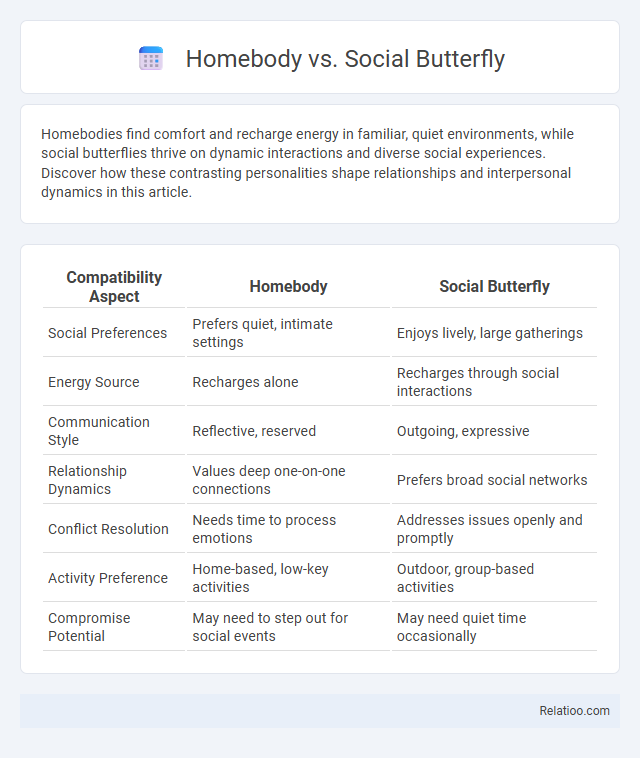Homebodies find comfort and recharge energy in familiar, quiet environments, while social butterflies thrive on dynamic interactions and diverse social experiences. Discover how these contrasting personalities shape relationships and interpersonal dynamics in this article.
Table of Comparison
| Compatibility Aspect | Homebody | Social Butterfly |
|---|---|---|
| Social Preferences | Prefers quiet, intimate settings | Enjoys lively, large gatherings |
| Energy Source | Recharges alone | Recharges through social interactions |
| Communication Style | Reflective, reserved | Outgoing, expressive |
| Relationship Dynamics | Values deep one-on-one connections | Prefers broad social networks |
| Conflict Resolution | Needs time to process emotions | Addresses issues openly and promptly |
| Activity Preference | Home-based, low-key activities | Outdoor, group-based activities |
| Compromise Potential | May need to step out for social events | May need quiet time occasionally |
Understanding the Homebody Personality
The homebody personality is characterized by a preference for comfort, solitude, and familiar environments, favoring quiet activities like reading, cooking, or watching movies at home. Understanding your homebody traits helps in recognizing the value of downtime and self-care, contributing to mental well-being and energy restoration. This personality contrasts sharply with the social butterfly's need for external stimulation and frequent social interactions, demonstrating diverse lifestyle preferences driven by individual temperament.
Traits of a Social Butterfly
Social butterflies exhibit traits such as high extroversion, strong communication skills, and a natural ability to network effortlessly in various social settings. They thrive on interaction, regularly seek new experiences, and maintain a wide circle of friends and acquaintances. Their lifestyle often includes frequent social events, lively gatherings, and active participation in community or group activities.
Benefits of Embracing Time Alone
Embracing time alone enhances self-awareness and mental clarity, allowing you to recharge and cultivate creativity. Homebodies enjoy the benefits of quiet reflection, which can reduce stress and improve emotional resilience. This intentional solitude supports a balanced lifestyle, complementing a social butterfly's interactions by maintaining personal well-being.
The Joys and Challenges of a Social Lifestyle
Navigating a social lifestyle offers the joys of vibrant connections and enriching experiences, but it also presents challenges such as maintaining energy and balancing commitments. You may find immense satisfaction in building relationships and attending events, yet the constant social engagement can lead to fatigue and limited personal downtime. Embracing this dynamic lifestyle requires mindful management to enjoy the benefits while preserving your well-being.
Homebody vs Social Butterfly: Key Differences
Homebody individuals prefer the comfort of their own space, enjoying solitude and quieter activities, whereas social butterflies thrive in group settings, seeking constant interaction and social engagement. Your lifestyle choices profoundly influence mental health, energy levels, and relationship dynamics, making it essential to understand whether you lean toward introversion or extroversion. Recognizing these key differences helps tailor your daily routines and social commitments to better suit your personality and well-being.
Finding Balance Between Solitude and Socializing
Finding balance between solitude and socializing involves recognizing personal needs for downtime and meaningful connections. Homebodies recharge through quiet, reflective activities, while social butterflies thrive on interaction and dynamic environments. Embracing a lifestyle that honors both introverted solitude and extroverted engagement fosters emotional well-being and a more fulfilling social experience.
How Your Personality Shapes Daily Habits
Your personality profoundly influences your daily habits, shaping how you interact with your environment and others. Homebodies often prioritize comfort and solitude, creating routines centered around relaxation and personal space, while social butterflies thrive on frequent social interactions and dynamic schedules filled with events and gatherings. Lifestyle choices reflect these tendencies by aligning your activities, energy levels, and priorities with your innate social preferences, impacting productivity, well-being, and overall life satisfaction.
Navigating Relationships with Opposite Personalities
Navigating relationships between a homebody and a social butterfly requires understanding and respecting each other's lifestyle preferences, as homebodies thrive on solitude and comfort while social butterflies seek constant social engagement and stimulation. Successful interactions depend on balancing personal needs by setting boundaries that honor introverted tendencies alongside extroverted desires. Open communication about lifestyle differences fosters empathy, reduces conflict, and strengthens emotional connections despite contrasting personality traits.
Tips for Homebodies to Broaden Social Skills
Homebodies seeking to enhance social skills should start by practicing small talk in low-pressure environments such as neighborhood events or hobby groups. Setting achievable social goals, like initiating one conversation per week, helps build confidence progressively. Engaging in virtual social activities can also provide a comfortable space to improve communication without overwhelming sensory input.
Embracing Your True Self: Homebody, Social Butterfly, or Both
Embracing your true self means understanding whether you thrive as a homebody, a social butterfly, or a blend of both lifestyle types. Homebodies find comfort and rejuvenation in solitude and personal spaces, while social butterflies gain energy from engaging with diverse social circles and events. Recognizing and honoring your unique balance between these lifestyles empowers your well-being and authentic self-expression.

Infographic: Homebody vs Social Butterfly
 relatioo.com
relatioo.com